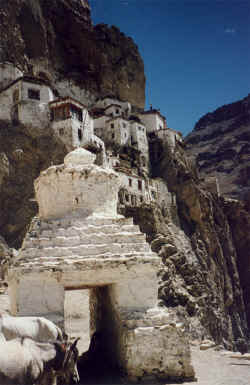MyHimalayasimpressions from |
|
|||||||
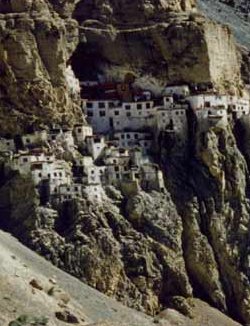
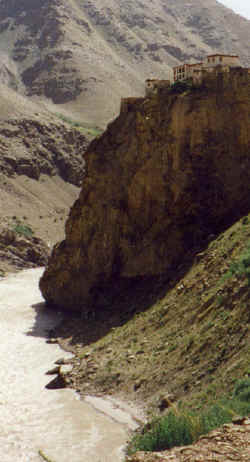
Bardan monastery watches the entrance to the Lungnak valley..
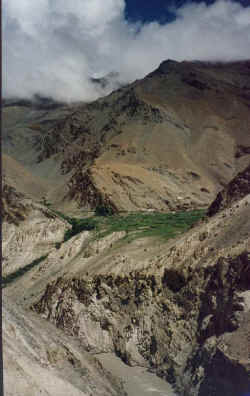
Steep rockfaces and narrow valleys are characteristic of Zanskar, on the few
plateaus glacial water is used for irrigation.
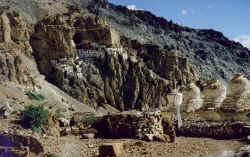
Monastery Phuktal:one of the most stunning monasteries in the whole Himalayas.
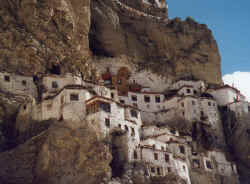
The white buildings seem like a swallow nest clinging to the sheer rock faces.
Zanskar: Padum - Phuktal
Padum - Phuktal
Padum to Rera
First day of trekking! To be honest, after ten days of driving and seeing so many things I don't see a reason for walking. The treks I've done before in Nepal were different. In order to get to nice or interesting places, I just had to walk. In Ladakh, everything was within easy reach by car. Hopefully I'll feel better about hiking after this first day.
We leave Padum at 8 a.m. I wouldn't mind starting earlier when it's cooler. Right after sunrise the light is also better and accentuates the landscape more. After that the brightness of the sunlight blurs the different colours which make this landscape so fascinating. We walk in the Lungnak valley. Lungnak means 'dark valley' and is called that way because some of the rocks are black and the valley is rather narrow. The river which flows in it is called Tsarap, tsa meaning 'salt', 'rap' is a shallow spot where the river can be crossed. Merchants from Tibet who brought salt had to cross this river. It's a dull walk,it's hot already and the valley doesn't offer much in the way of great views. The government wants to build a road for vehicles along the river. At one point a big rock is about to be blasted away. We have to hide behind a curve and can hear about eight explosions. They question is, are those all or are there more to come? Judging by the insecurity of the workers nobody knows for sure.
Two hours later, we see a monastery on a very high rock. This is Bardan, 'where the sign of religion is visible'. In the 16th century a monk was on a pilgrimage in Zanskar. During prayers, a raven stole one of his butterlamps and put it on a hill which was in the form of a conch. In Tibetan Buddhism conches are holy symbols. Seeing that sign, the monk blessed the place and gave it its name. Today the monastery belongs to the Lho-Drukpa sect from Bhutan, a small country east of Nepal. The Gonkhang is different from the ones I've seen so far. The first thing I notice is the suffocating air. When my eyes get used to the darkness, I see that the smell coming from huge blocks of rancid butter. The room is full of them, brought here by pilgrims as offerings. It's supposed to protect the cattle. The butter is used for the butter lamps, the milk of yaks has so much fat that it burns like a oil.
At noon we get to Murney. The town is nice, but the building where we wait for the cook is depressing. The owner seems weird, children play in the dirt, young men drink chang and smoke. The campsite should be near. The weather has changed rapidly. Before lunch, it was clear and there was a cooling wind blowing softly from the west. Half an hour later dark storm clouds are in front of us, a heavy wind blows from the east. It's so strong that it knocks down a prayer flag. I hope to make it to the campsite, which is one hour away, without getting too wet. Luckily the clouds are blown further away. The campsite is by a shallow lake, it's a nice spot.
Today's six hour walk wasn't very exciting. It's been a dull walk along a brown river with little else except stones. I don't know what I expected, but I hoped for more diversity. But I'm sure it'll get better.
Thunder is rolling when we put our tents up, but it doesn't worry me. If it rains, well, there's nothing I can do about it, so worrying is useless. I definitely wouldn't think that way in Switzerland and just accept it, but things here are simply different. When you're close to nature it's easier to accept the not so pleasant aspects of it. One hour later it starts to rain. It's just a few drops, but one minutes later it's almost torrential. The rain increases at dusk, during dinner the kitchen tent is already leaking. I just hope my tent is better. It really is and keeps the water out, after midnight the rain suddenly stops.
Rera to Pepula
I've slept much better than in Rangdum. Even though my sleep can't have been deep (I noticed when it stopped raining in the middle of the night), I woke up only once. I'm up early and look forward to a stunning sunrise. I open the tent and see grey clouds, a big disappointment.
What does a normal trekking day look like? Often I wake up around sunrise at 5.30 and enjoy the views. Official get-up time is 6.30, half an hour later there's breakfast. Usually it's porridge and chapati (a thin Indian bread) with butter, honey or jam. Then we take down the tents and leave. The two horseman put all the luggage on the five mules and five horses. The cook prepares lunch and leaves an hour after us. On short days we walk to the campsite without stopping for lunch. But usually there's a short break at noon; the cook arrives a few minutes after us and we have a fantastic lunch. Most of the dishes are vegetarian, the five chickens they've bought are eaten mostly by the cook and his assistant because even the non-vegetarians aren't very keen on chicken. There's a lot of plain rice, a bowl of vegetable curry and lentils. I've turned into an eating machine up here, I don't know whether it's the altitude, the walking or the excellence of the food. I eat four big plates with rice and vegetables, and a bit less for dinner. After lunch, we usually have to walk for about two hours to get to a nice campsite. The horses get there an hour after us. Once the tent is up, I take a nap, write my diary or walk around if there's anything interesting to see. In the afternoon there's tea with biscuits. Yes, this is an unnecessary luxury but very enjoyable nevertheless. At 7 o'clock we have dinner. It's also rice and lentils, often there's spinach with tofu-like cheese in it. I stick to those local dishes, and ignore the more elaborate things like spaghetti or vegetable pie. One hour later, I crawl into my tent, read for a few minutes and fall asleep. We're closer to the equator than in Europe and when the sun disappears it gets dark really fast. It's also much colder than during the day, so the best place is the sleeping bag. That's our daily routine.
At least it's not very hot today, this only good thing about clouds. We only have to walk only a short distance, a mere four hours. The hike seems more interesting, there are more bends in the river; situated on the opposite side are villages and fields, and even our side is greener than the day before. Small bushes and colourful rhododendrons grow here. Maybe the landscape hasn't changed at all and my mind has simply accepted the fact that the next ten days will be spent walking. After half the distance it starts to rain lightly, but stops after an hour.
I walk with the cook and since his English is pretty good we have an interesting conversation. Indhar is from Pokhara, the second largest city in Nepal, but he has been working in India for the last 10 years. He's been with World Expeditions for quite some time and has worked in all parts of northern parts of India: Ladakh, Zanskar, Himachal Pradesh, Rajastan and Sikkim. He earns 3000 rupees a month (US$ 100.-) and gets paid vacation. This is pretty good for Indian standards, but he can only see his family in Nepal every 4 months. His wife takes care of their two daughters and organises the work in the fields.
The scenery remains the same for the rest of the day and the clouds are also still there, but it doesn't rain. We reach the campsite near the river. One of the things I love about trekking is resting. Of course I don't mind the walking itself, but it's just a means of transportation and things like great views, interesting conversations and encounters and rest are the rewards for it. I have a big blister on my little toe but hopefully it won't bother me in the days to come. My legs are a bit sore, but otherwise I feel great. My cold is gone and the stomach problem doesn't call for too many toilet stops. During a long afternoon in the tent (it's drizzling outside), I can fully catch up with my diary (I didn't write when I was so sick).
Pepula to Purne
We've camped next to the river, but I've slept surprisingly well. Only in the morning does the rush bother me after my earplugs have fallen out. It's still cloudy and we've walked for 20 minutes when it starts to drizzle. As long as my weatherproof jacket keeps me dry I don't care. Of course it'd be nicer in sunshine, but my mind is set on walking. It blocks out the things that are not important; I also seem to think less. Time passes quickly. I can't really explain what I do when I walk for so many hours a couple of days. Many people think it's boring and don't understand how I can do it. Admittedly the first day is strange, but after that I get used to it and the mind just keeps itself busy. Sometimes I feel like I've been walking for an hour without thinking for a second.
The rain gets heavier during the next two hours, but since the valley is broadening and the views are getting nicer my mood is getting better. I start to really enjoy this. For the first time since Rera we see a few houses on the other side of the river. When we reach the village of Chu, the sky clears up and the sun comes out from the clouds. This seems trivial, but it makes me extremely happy. The boring valley ends here and so the landscape offers more diversity: high mountains, dune-like hills and another valley which looks more like a canyon.
Today's campsite in Purne isn't far away and there are two paths leading to it. A safe one high above the river and just next to the river a shorter one, which is sometimes washed away. When we reach the fork, a horse caravan is just coming from the lower path, so it's safe to go that way. Great! It's much cooler to walk next to the water, and we don't have to climb the hill. The lower way is also spectacular. This is an amazing afternoon. Soon we get to a new bridge, it was finished just two days ago. I know how much it takes for something be repaired in India, so I'm very glad we didn't have to cross the river two days earlier. After a short climb we walk through a chorten and follow a mani wall. We're in the small two-family village of Purne. This is where we'll stay for two nights.
I'm starving. I didn't eat much for breakfast, so after four hours of walking I'm very hungry. It's a great relief to me when I see two dots in the distance, it's probably Indhar and Buphandar with lunch. By the time they get here, it's drizzling again. The family lets us stay in the guest room, which is a very nice room with thick carpets on the floor. It would be even more pleasant if it weren't for their obnoxious 10-year-old daughter. The nearest school is in Cha, 11/2 hours away, and so children from here don't go to school. I think school also teaches social skills and interaction, which this girl hasn't learned yet at home. Of course you could also say that school tries to change children and form them into something useful for society, in which case it would good that the children don't have to go. Anyway, I try to ignore her and enjoy my lunch.
Phunchok, the leader of the group, usually works as a teacher. He's a tour guide only in the big tourist season in July and August. School is mandatory for children over 5. A school is in every bigger village, which means that some children have to walk one hour to school and another hour back home. School is from Monday to Friday, each day from 10 a.m. to 4 p.m. with a lunch break, when kids sometimes get food from the school. In southern India providing lunch has increased attendance. When I ask Phunchok what it's like here he says that parents have recognized the importance and value of good education and are happy to send their kids to school. There's one teacher for up to 30 children in different classes. In high school they learn geography, history, science, and four languages: Ladakhi, Urdu, Hindi and English. If you consider that all four languages have a different alphabet and Urdu as an Arabic language is even written from right to left, there's a lot for those children to learn.
Apparently there's enough time for the children to work on the fields or herd the cattle. It's very important that they learn those things. too. If they don't succeed in school or their parents can't pay for further education after high school, they can still work as farmers and so aren't totally lost. Bright children whose parents can afford it go to one of the two colleges in the area. The colleges in Leh and Kargil only teach a few subjects. More subjects are taught in Srinagar, 400 km farther west. But if you consider that there's a civil war and it's a Muslim city I doubt that many parents want to send their children there. But those with a college degree have problems finding an adequate job here. Many of them have to work as farmers.
A teacher's lifestyle isn't easy either. Most of them can't teach in the village where they live. If they're sent to a remote school they have to live there in a single room where they sleep, cook and work. Once every few weeks they can go home to their families for a few days.
Phunchok wants to send his only daughter to a Tibetan school in Dharamsala. But the fees are very expensive, which is why he works as a guide in the summer. It's amazing how highly education is valued and that most parents only want to have one or two children, because they feel they couldn't take good care of more. Kids aren't seen simply as an old-age pension anymore. I wonder if this change of attitude is taking place in other parts of the world, too.
This will be another lazy afternoon - nap, tea, diary writing, nap, dinner, sleep. But I get the crazy idea that I should wash myself, the first time since Padum. I find a small waterfall. If I were courageous I'd stand under it for five seconds, put some soap on and wash it away. But the water is freezing (quite literally, it comes from a nearby glacier) and, maybe more important, I'm a wimp. But I still wash myself and even do my laundry. This should be good enough for the next 4 days.
Purne, Phuktal
What a beautiful day! I wake up before 6 a.m. and get up. It's shortly after sunrise. The light is very warm but not glaring, sun rays turn the barren mountains into a golden light. Where the sun hasn't reached, it's still cold and dark. Two hours later we leave for our day trip to Phuktal, maybe the most stunning monastery in Zanskar. Phuk is Ladakhi for 'end of cave', tal means 'too much'. The monastery is built around a cave and it seems to be built into the mountain, which gave it its name.
It's a mere two-hour walk to get there. "Two hours of walking, no!" I might have thought a week ago, but now it's more like: "Only two hours, not bad." It is wise to leave early while it's still cool. As usual a small path follows the river. Purne lies at the meeting of two rivers, the Kurgiakh Chu from the south and the Lingti Chu from the north east. After fifteen minutes a narrow valleys lies before us and we leave the small fields of Purne behind. The side we're walking on is still in the shade. Not much grows here with rhododendrons the only large plants. But this only makes the landscape more fascinating; nothing distracts the eye from the stones which seem to glow in different reds in the morning sun. That's one of the nice things about trekking, you start to pay attention to things you normally ignore. Soon we reach a bridge (also newly built, which is lucky even though it means that I can't bring back any pictures of Indiana Jones-like bridges) and are almost in Phuktal. This can't be, it felt like a 20-minute walk. I'm surprised to see that many local people on their way to the monastery. Many are dressed in local costumes, women have put on their finest jewellery. Most of them walk, the ones from further away ride horses. A visiting high lama is giving a religious speech this morning. Two men who passed us yesterday bring a young yak as a present. A few minutes later chorten and long mani walls announce the monastery. We walk around a corner, and there it is, absolutely stunning. It looks as if it was glued to the vertical mountain wall. How can somebody find such an amazing place to build a monastery? How can human hands build something like this?
Legends say that three brothers discovered the cave and meditated in it. After finding enlightenment they flew away, each in a different direction. In the 15th century they showed Sherap Zangpo the way to the cave. When Sherap Zangpo left Tibet to establish the Gelupka sect in Ladakh, the founder of this sect, Tsonghapa, foresaw that he should see three mystic creatures. The three brothers led Sherap to the first chorten; when he found the cave he meditated and built the monastery.
Another story tells how the monastery escaped looting from the Mongols in the 16th century. A Mongol wanted to steal things from the monastery and put a rope on the cedar above the monastery to climb down. Halfway down he saw Palden Lhamo, the female protector, who changed into a monk and cut off the Mongol's hand with a long sword. The mummified hand has been kept and is still shown today during a festival in winter.
Most of the 40 monks are in the assembly hall where they hold a ceremony. Their age varies from 7 to 70, but even the young ones recite the texts without too many gaps. Every five minutes there's a break to fill up their cups with butter tea. Again, it'd be nice to know what exactly is happening, but I couldn't find a description of the ceremony in the book I've read. At least I figure out the seating arrangement. It's very hierarchical, the head of the monastery sits closer to the altar, while the young monks and lay people sit near the entrance.
I'm the only non-monk in the assembly hall, all the other people go to the big white chorten in the cave. It's seems to be the real object of devotion, locals walk around it clockwise several times. To sit there and watch them is as interesting as the monastery itself. A well springs from a hole in the cave, and if you consider that the whole construction faces south it's easy to imagine that this must be a relatively comfortable place to live in winter when rivers freeze and snow lies in the valleys.
It's still hard to understand what made people walk so far just to find caves and live in them. But I think I'm beginning to realize that if you live such a hard life and your primary goal is simply to survive in the harsh conditions, you need something to believe in. There must be something else, something higher and more pure than the daily hardships.
The Gonkhang, room of the protectors, is the building furthest up. All the statues are covered, judging by the pieces that can be seen: Yamantaka, Palden Lhamo and various forms of Mahakala. It'd love to see the whole group uncovered. Those terrifying statues are fascinating, somehow I feel more attracted to them than to the lovely, pure golden statues of Buddha.
The room in front of the Gonkhang looks like a very old assembly hall. A few thankas hang on the wall, but it's impossible to see what's on them. I don't know if it's their age or incorrect handling that has destroyed most of the colours. A very rare item is the three dimensional mandala, a palace with several statues in it. This aid to meditation is usually painted or made out of sand and looks totally different, but it represents the same concepts and ideas. The two-dimensional mandala is simply the floor plan of the three-dimensional mandala. The statues in this room all belong to the 'nice and lovely category': Tsongkhapa, Avalokiteshvara, the future Buddha Maitreya and the three brothers who have found the cave.
I wander around and find myself in the kitchen. It's a big cave with blackened walls and ceiling. True chefs don't need great equipment (Indhar is proof of that), but I'd be very surprised if any delicacies came out of this kitchen. All that's in here are three fireplaces, three big pots and a few utensils. A monk is busy making tsampa, while others brew butter tea. Next I'm in the part where the monks live: their houses are fifty feet away from the assembly hall. I carefully look over the small rim of the roof I'm standing on. It goes straight down for at least 180 feet! The only material they use are clay bricks, wood and stones, which aren't the most reliable materials, I suppose.
I spend almost two hours in Phuktal without becoming bored. On the way back we can hear the sound of instruments, this could be the beginning of the lama's speech. Many parts of the path are still in the shade, since the path is often built in vertical walls. It's such a nice walk that I'm surprised to see the fields of Purne so soon. Instead of spending the afternoon climbing some hills and exploring, I sit around, which is of course a waste of time. But somehow I feel I've seen so many things this morning that it's enough for today.
It's very windy and with more and more clouds above us, a storm seem unavoidable. Tomorrow will be a long day, 8 hours walking, so I enjoy the rest and hope for good weather.
|
Summary Part 2:
Yesterday's little sidetrip to Karcha gave us a taste of trekking and its rewards. We follow the river in the Lungnak valley and pass the impressive Bardan monastery. Settlements are less frequent and become smaller, in this small valley agriculture is almost impossible. Low hanging clouds do not make the valley more interesting, but luckily rain is rare. We spend one rest in Purne and take the chance to visit Phuktal monastery. Two hours up a little side-valley the cave monastery is built on crags over a sheer cliff, one of the most stunning settlements in the whole Himalayan range. Many locals in bright costumes and jewellery visit the gompa to see a famous lama. Just the monastery alone is worth visiting Zanskar. |
